

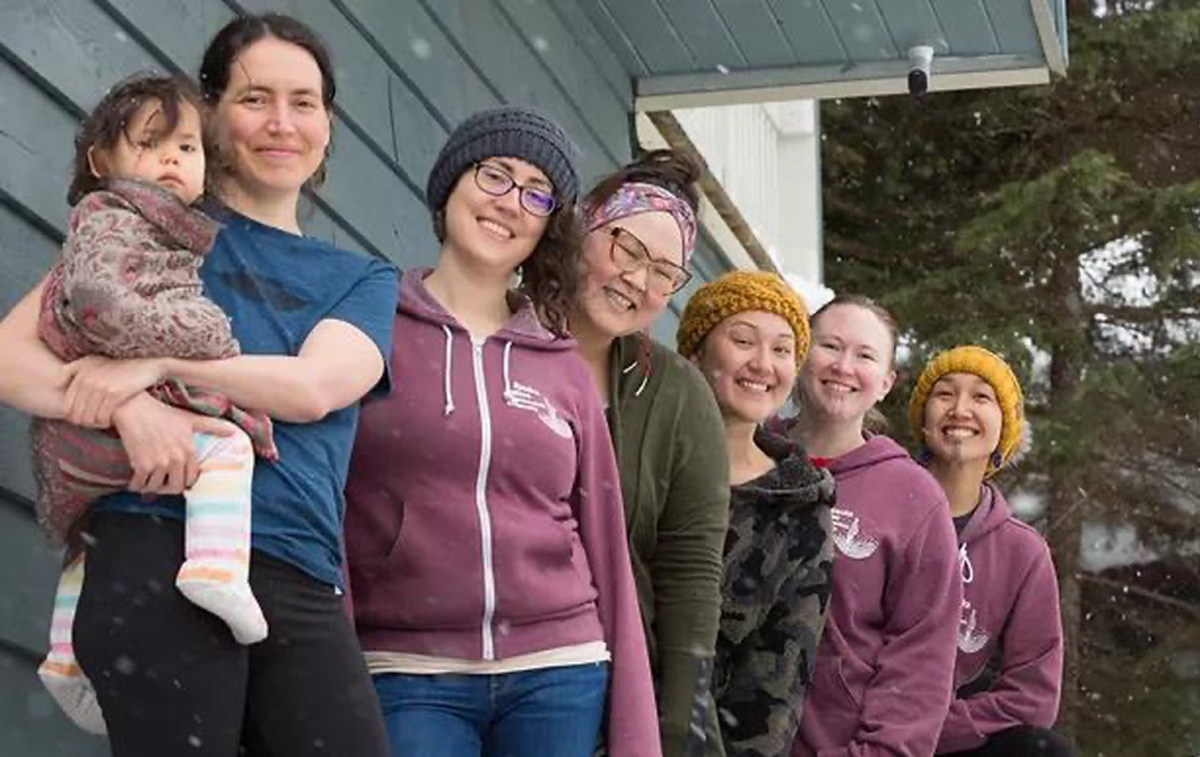
“Sovereignty From the First Breath”
f you have given birth or been intimately involved with the arrival of a baby, you know what an awe-inspiring, transformative, and all-encompassing experience it is. It’s also an enormous challenge: even a birth that is free of major complications is hardly all storks and snuggles.
For Alaska Native individuals there are often extra complications, some of them stemming from historical policies that extinguished our traditional methods of caring for parents and families, and others more specific to the contemporary healthcare system or structural racism.
Aware of these challenges, a small group of Alaska Native women have been crafting an alternative for the last several years, founding the Alaska Native Birthworkers Community (ANBC). And their impact is growing; in 2021, their network directly served more than 300 people—both Native birthing families and Native birthworkers.
And, according to its founders, the group is just getting started.
To illustrate some of the work they are doing, and the difference it makes, I want to share the story of my first daughter’s birth this winter. I know that even without the help of ANBC, I likely would have fared okay; I have a strong support system and a spouse, and have been exposed to pregnancy and birth through volunteer experience, family, and friends. But I also know that without ANBC it would have been a much harder experience during every stage, from pregnancy to postpartum, and I believe this group provides the kind of care and consideration all Native families in Alaska deserve.
At its core, ANBC is a group helping Indigenous families through the birthing process. Based in Anchorage, they focus on bolstering and filling gaps in maternal care at no cost to Native families, including assisting with births, education, breastfeeding counseling, nutritional guidance, postpartum healing, public health research, and advocacy. To ANBC’s founders, true sovereignty for Alaska Natives means “reclamation of Indigenous power during rites of passage that are rooted in ancestral knowledge, and each birthing person being surrounded by their community in connection to their sacred lands and waters.”
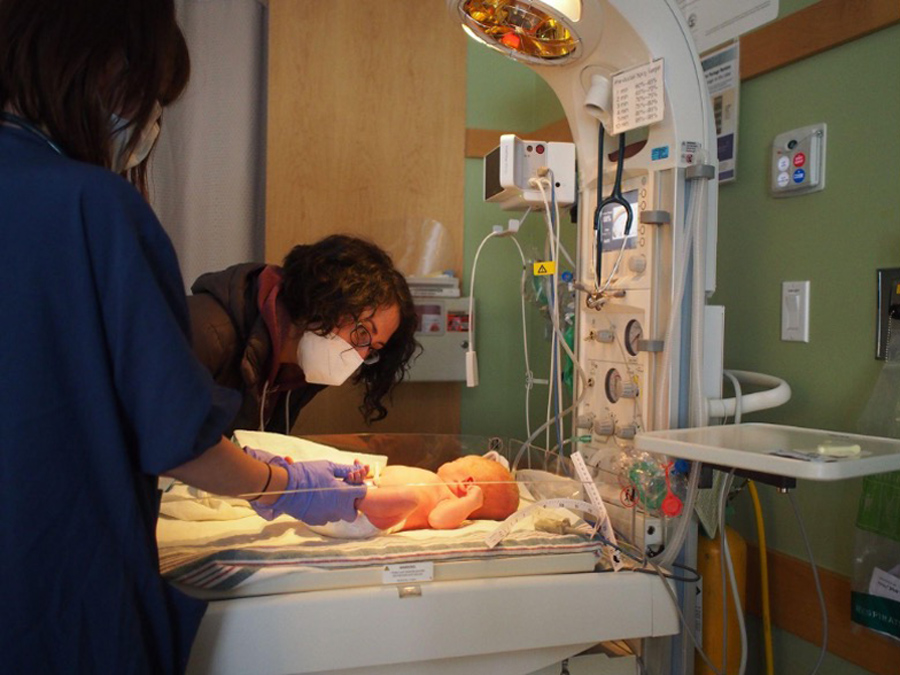
Founded in 2017, ANBC is fiscally sponsored by New Venture Fund/Alaska Venture Fund, a nonprofit organization. ANBC has seven birthworkers providing regular services through the organization—both in a volunteer and paid capacity—and their larger network includes more than 30 current and aspiring birthworkers across Alaska. ANBC largely serves in-person births in Anchorage to both Anchorage-based and rural families who travel to our state’s largest city to give birth (roughly half of all births at the Alaska Native Medical Center in Anchorage are to non-Anchorage families). Other virtual services ANBC provides are available statewide.
The ANBC birthworkers do not make medical decisions for you, but instead help you ask the right questions to ensure you receive the care that you want from your midwife, doctor, or provider team. They refer to themselves as “birth helpers” or “birthworkers,” which a lot of people in urban Alaska and the Lower-48 would probably call a doula—a name derived from the ancient Greek term for “female servant”—but not commonly used in Alaska Native communities.
For my prenatal care, I was fortunate enough to be seen by Margaret, a Certified Nurse Midwife with Southcentral Foundation. And Lena quickly replied to my ANBC online request that she’d love to be my assigned birth helper. Over the subsequent months, Lena and I had several Zoom calls to check in on how my pregnancy was going, go over a birth plan template, discuss my preferences, and answer questions my husband and I had about the process. It was clear to me throughout our interactions that she has a heart for this work and possesses a gift for listening, sharing, and supporting.
The Work of the Alaska Native Birthworkers Community
ANBC recognizes the unmet need of providing support to Indigenous families in Anchorage. As recipients of the care received through the Indian Health Service and as providers of peer support in these same facilities, ANBC members witness that it has not been the standard model of care to provide non-clinical birth help, long-term postpartum, and breastfeeding or other peer support to birthing parents. ANBC notes that most of the obstetric care providers working in the tribal health care systems in Alaska are non-Native. ANBC views their role in “reclaiming” the birth helper role through “culturally-matched care” as one step to reconnecting birth knowledge back to communities.
ANBC is working on developing a curriculum to support a trained network of Indigenous birthworkers. Currently, there are no trainings available and easily accessible that are grounded in Native cultures, values, and knowledge systems in Alaska. Margaret, for example, had to leave the state to attend midwifery school.
While there are entities located out of state that provide internationally recognized doula certifications, ANBC has been seeking ways to indigenize this training and work, partnering with other Indigenous birthworker communities. In summer 2021, ANBC worked with two Indigenous birthworkers from Canada to offer a virtual full spectrum Indigenous doula training for 27 people from across the state from Nome to Hydaburg. The four-day course covered the history of birth for Indigenous women, reproductive justice, grief and loss, pregnancy, traditional teaching tools, labor and birth, postpartum, and caring for the caregiver. ANBC also provided an Indigenous Breastfeeding Counselor training in late 2021 for 23 individuals. This five-day course provided foundational lactation education that was Native owned, designed, and taught.
Lena’s Path to Becoming a Birth Helper
A few week’s after she helped in my daughter’s birth, I talked with Lena about the road she took to this point in her life and career, and she told me she’s always had a “nurturing, maternal instinct and personality.”
When Lena was 10 years old, she supported her oldest sister who lived with them and had a new baby, taking him on outings in the community and generally “mothering him.” However, years later when she attended the birth of that sister’s fourth child, she realized that she wasn’t prepared to offer labor support or be helpful during the birthing process. She ended up fainting at the birth and felt mortified for causing such a distraction during the experience when the focus needed to be on her sister and the baby. Lena promised herself that if she ever set foot inside a birthing space again, she would “need to know what to do.”
A few years later when Lena was living with her other sister Margaret who was pregnant, she observed firsthand the experience of a home birth midwife and the “holistic, healing care” that surrounded the perinatal time. Lena was present for this birth and calls it “one of the most beautiful, healing, calming moments I’ve witnessed.”
“There was a birthing tub, lavender candles, and calming music,” she said. “I thought, ‘birth can be like this?’ This is amazing!” She felt empowered by being helpful during the birthing process. And this time, she didn’t faint.
As the years went on, Lena realized through three of her own pregnancies and the sharing of those stories with other people, that the experiences she was having were unique. She was supported by Margaret not only as a sister, but as a knowledgeable birth helper (who later became a midwife), as well as by a strong support system.
But the more she spoke with other people, the more she discovered that her experiences were the exceptions, not the rule. “The experience of being well cared for during pregnancy and childbirth is not a right for everyone—which it should be—it’s a privilege for some,” she said.
This led her to wonder, “What can I do to support powerful and sovereign birth experiences?”
The family and community knowledge surrounding rites of passage, including pregnancy, birth, and raising a family was common a few generations ago, according to Lena. “Everyone in the family knew how to support a birthing person,” she explained. She saw a need to revive these practices that were “forcefully and very intentionally removed from Native communities.”
At first, Lena didn’t have any formal training, but by making herself available, friends and family started asking her to be present for their births. Since 2005, she has attended more than 20 births, sometimes bringing her own newborn daughters in their baby carriers.
In 2017, Margaret helped host a retreat in Alaska for birthworkers from across Canada and the U.S. that Lena attended. Following the event, the Alaska attendees wanted to continue the momentum, and decided to organize locally. They were inspired in particular by the National Aboriginal Council of Midwives in Canada. This small group eventually turned into ANBC. The founders of ANBC recognized a specific need for people being evacuated from rural Alaska villages to come to Anchorage to give birth—often without a partner or support person, who would have to pay their own way if they wanted to be on hand. For the first three years, the birthworker network was all-volunteer, then Lena started fundraising and finding grant dollars to support their work, transitioning some volunteers to paid roles, and seeing exponential growth in demand for their services and what they were able to provide.
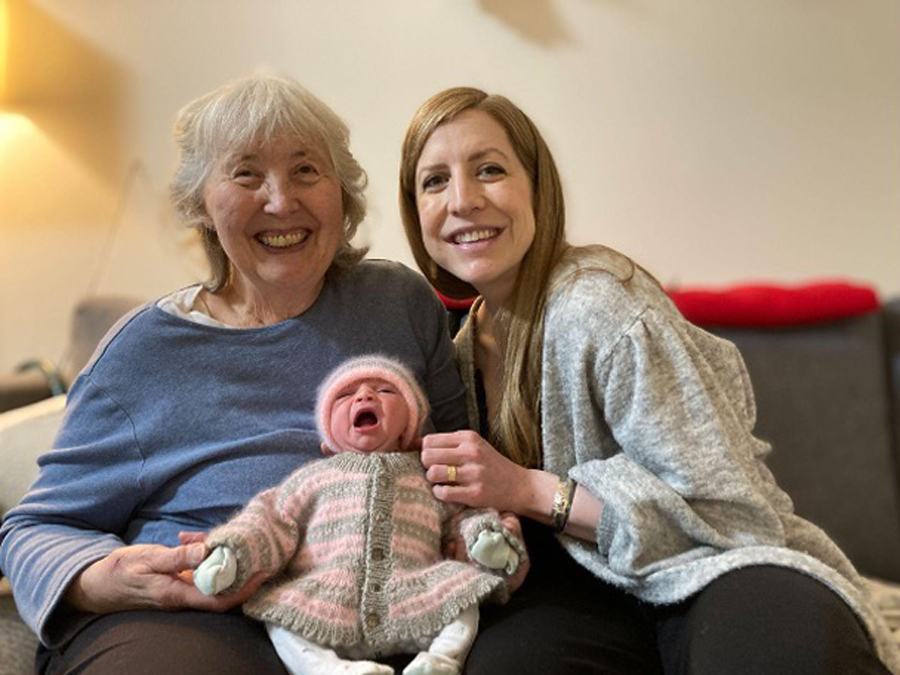
Unique Needs in Native Communities
But we don’t necessarily need statistics to tell us what we already know—decades of oppression under colonialist policies and structural racism has taken a toll on Indigenous communities. It makes sense that in the perinatal period when families need increased support from the healthcare system and their communities, these barriers can present increased challenges in achieving health equity.
However there is one data point in particular that, to me, demonstrates how vital an effort like the ANBC is. According to 2007-2016 U.S. Centers for Disease Control and Prevention data, American Indian and Alaska Native women are more than twice as likely as White women to die from conditions caused or exacerbated by pregnancy.
Additionally, according to research in the journal Health Equity, pregnant individuals of color—particularly Black and Indigenous people—experience significant disparities in birth outcomes compared with their White peers. Research has associated the stress resulting from daily exposure to racism with higher rates of preterm births and low birthweight, depression, and post-traumatic stress disorder, as well as a reduced probability of breastfeeding. Communities of color also report challenges in receiving prenatal care, including brief encounters with healthcare providers, extended wait times for appointments, and gaps in communication. This same research notes that community-based birthworker/doula services can positively impact birth outcomes, especially for Indigenous populations. Birthworkers not only provide physical, emotional, and informational assistance to pregnant individuals, they can also offer additional support to address the experiences and effects of structural racism. This can increase a pregnant person’s trust and engagement, strengthening their ownership of decision-making about their care.
It is positive outcomes like these that serve as a rallying cry for the ANBC and its supporters. ANBC notes that pregnancy can be an opportune time to work with families to increase wellbeing for an entire household, since a pregnant person may be especially motivated and open to healing and positive health changes to benefit their baby.
My Story
Though in the years since I’ve seen many family and friends happily deliver in rural healthcare facilities and birthing centers, I knew I wanted to have our first child in a hospital. Thankfully, by the time our baby was due, COVID restrictions at the Alaska Native Medical Center allowed for one support person and one certified birth helper to be present. This meant my husband Zach could be by my side (and occasionally dozing on a couch), as well as Lena. Well in advance, Lena blocked out her calendar around my due date and gave me her cell phone number, telling me to call or text any time.
On January 27, I started to have what felt like menstrual cramps. But they came irregularly, and as a first-timer I wasn’t sure when “cramps” turned into full on “contractions.” I took a bath and tried to distract myself with tasks of the day, including working from home, chatting with my mother, who had recently flown in from Sitka, and taking her on an errand. All the while trying to breathe through the increasing pain. I texted Lena throughout the day for advice, feeling more secure whenever I received a bit of digital support or guidance about what I was experiencing. She offered to come by my house, but at the time I didn’t think it was necessary: my cramps weren’t regular and my water hadn’t broken—‘I shouldn’t exhaust her generosity if this isn’t the real thing,’ I thought.
At some point that evening I managed a grunt to my husband, “It’s time to go to the hospital.” He and my mom were midway through chewing their dinner and sprang quickly into action, running around the house with mounting urgency. At one point, as Zach was trying to gather up supplies for the hospital, he frantically tried to add a few last minute items to the birth bag. But he unzipped it upside down, the contents, packed carefully over the course of weeks, spilling across the floor.
A couple hours later at the hospital, once I had been cleared in triage to be admitted, Lena arrived with her bags of birthing goodies in tow. Zach was still in shock, adjusting to the reality that we were in fact at the hospital after what had seemed like a largely normal day to him.
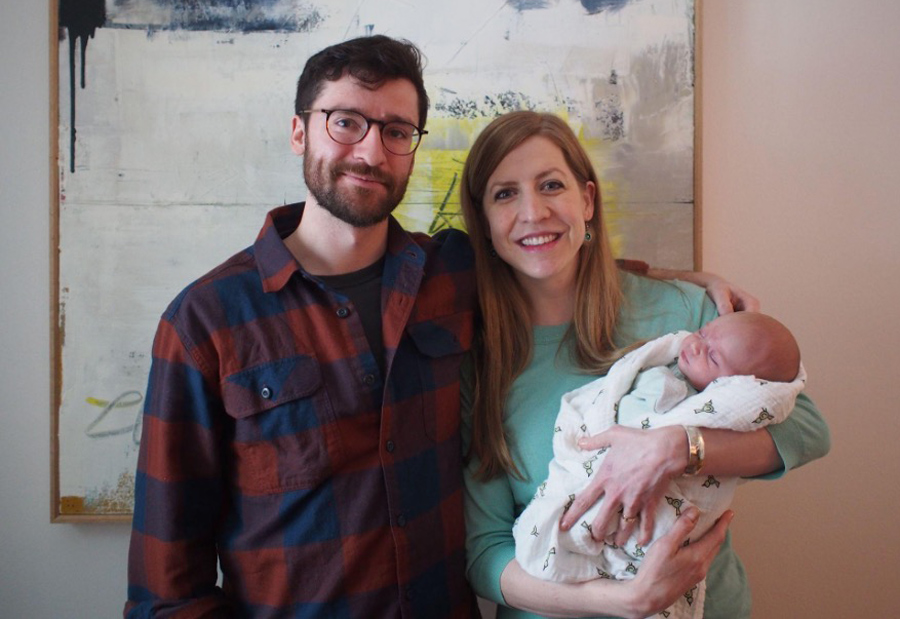
When our daughter, Loretta Latseen, arrived on the morning of January 28, Lena captured photos of the first moments of her life—pictures that we’ll always treasure. She helped welcome our baby into the world as a friend and fellow Native sister, something that in the pandemic when visitation is not allowed in the hospital, was very important to me. Lena stopped by our home a week later to bring cupcakes, check in, and help us figure out how to use a baby wrap that was perplexing us. Her continued presence helped me feel safe and supported in what’s known as the “fourth trimester,” when the body is healing, adjusting to parenthood and sleep deprivation, and hormones are all over the place.
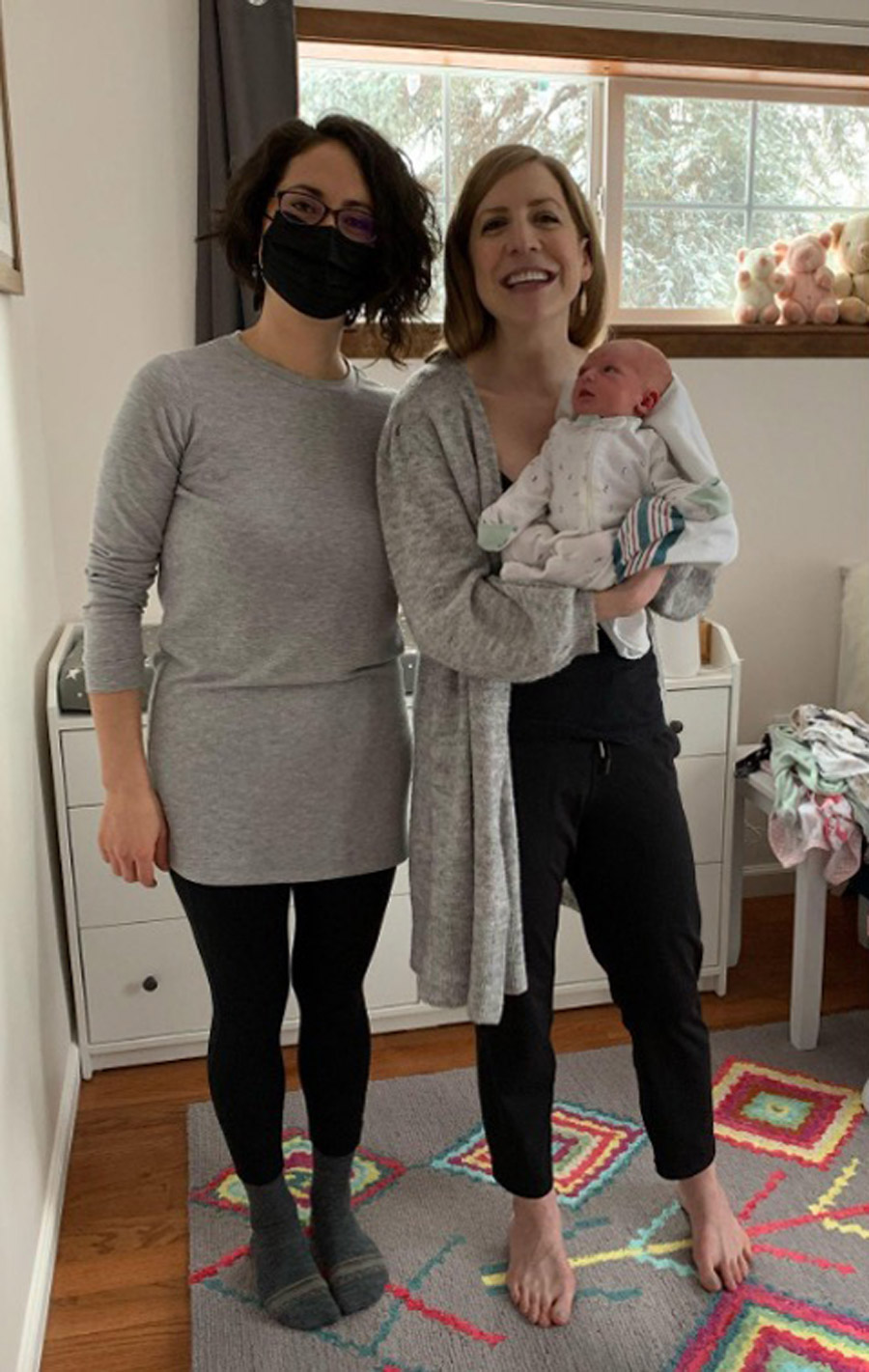
My mother and I participated in one of ANBC’s virtual talking circles the week following the birth, catching up with Margaret and processing my birth experience with her and two other birthworkers in training. They validated my rapidly shifting emotions, expressed joy at Loretta’s growth and health, and held space for my mom to open up about her own birth experiences decades earlier.
My mother, who is Lingít, Japanese, and Caucasian, shared stories I hadn’t heard before about complications she experienced with the births of my two siblings and me and the challenges of being medevaced to larger communities to give birth. Hearing her stories, I realized that birth experiences stay with you for a lifetime. Having the space to talk about it and process, no matter how much time has passed, was a gift that ANBC gave to my mother and me.
I’m so grateful to the amazing women of the Alaska Native Birthworkers Community and also their families that support each of them in this demanding and essential work. I hope that by sharing my story, I can inform others of the critical work they do in our community and state, and encourage other Native families to reach out for their eager and healing support.